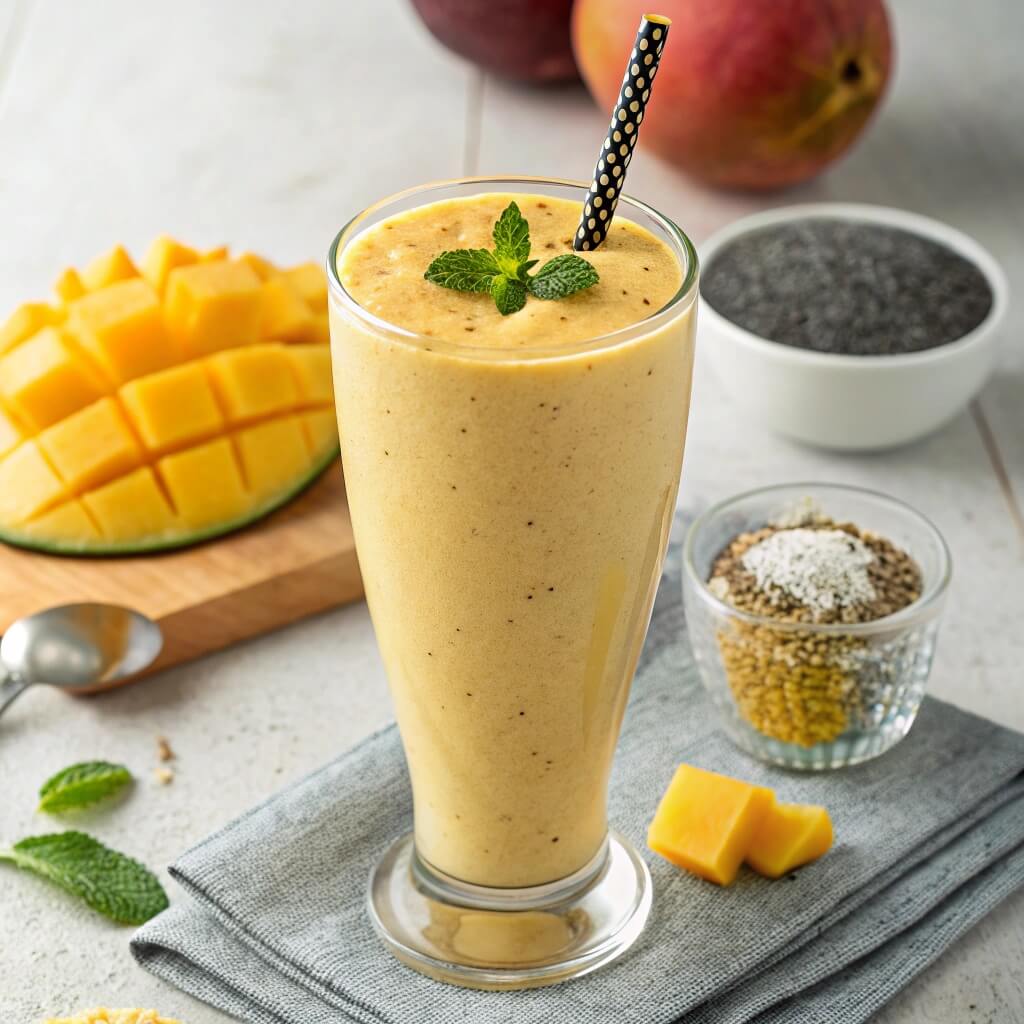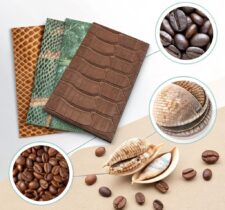The mango protein smoothie provides a fast, nutrient-dense solution for busy days. This easy recipe mixes frozen mango chunks, almond milk, hemp protein powder, and matcha for a drink that’s not only refreshing but also filled with benefits. With only 3 cups of almond milk, 2 cups of frozen mango chunks, two scoops of vanilla hemp protein powder, and one teaspoon of matcha powder, you can produce a smoothie that’s gluten-free, dairy-free, heart-healthy, low-fat, and ideal for both vegetarians and vegans.
This combo is exceptional because it nicely matches a meaty pulao meal. In many South Asian families, pulao (or pilaf) serves as a meal, while the smoothie is an excellent accompaniment. For example, the Kumar family in Delhi routinely cooks mango smoothies with veggie pulao for Sunday breakfast, finding that the protein-rich drink balances the carbs in the rice dish. Similarly, eateries like Spice Garden in Mumbai have begun providing mango protein drinks with their pulao main meals as side choices.
But why do these meals function so well together? What particular health advantages may you obtain from this combination? And how can you change these recipes to fit your taste preferences?
The Perfect Mango Protein Smoothie: Ingredients & Benefits
Understanding Your Smoothie Base
The mango protein smoothie recipe involves only four basic ingredients, yet each is crucial in generating a balanced drink. Almond milk serves as the liquid foundation, delivering a dairy-free option rich in vitamin E. Unlike cow’s milk, almond milk has fewer calories while still having a creamy mouthfeel. The three cups used in this recipe give the right consistency—not too thick and not too runny.
Frozen mango chunks deliver natural sweetness without extra sugars. Mangoes contain about 20 distinct vitamins and minerals, notably high quantities of vitamins A and C. These nutrients assist immunological function and skin health. Using frozen mango reduces preparation time and gives the smoothie a delightful chilly temperature without diluting it with ice.
Hemp protein powder delivers high protein content without animal products. Each scoop typically offers 15-20 grams of complete protein, meaning it delivers all nine necessary amino acids your body can’t make on its own. Hemp protein also includes fiber, healthy fats, minerals, magnesium, and iron. The vanilla flavor compliments the tropical mango taste without dominating it.
The matcha powder may seem like a weird addition, but it serves numerous functions. This finely crushed green tea powder contains antioxidants called catechins, which may help decrease inflammation. Matcha also gives a modest caffeine boost (approximately 35mg per teaspoon) that distributes more slowly than coffee, offering prolonged energy without crashes. The earthy undertones offset the sweetness of the mango.
Nutritional Profile and Health Benefits
This smoothie has several health perks, making it more than a nice drink. A single serving (about 1 cup) delivers approximately:
- 150-180 calories
- 10-15 grams of plant-based protein
- 3-4 grams of fiber
- Significant levels of vitamins A, C, and E
- Iron, magnesium, and potassium
The low-fat content makes this smoothie heart-friendly yet tastes decadent. The mix of protein and fiber helps maintain steady blood sugar levels, reducing the crashes frequently associated with fruity beverages. This meal delivers post-workout recovery advantages for athletes or active folks by supplying protein for muscle repair and carbs that restore energy reserves.
Essential Ingredients for a Classic Pulao Recipe
The Foundation of Flavorful Pulao
Pulao (also called pilaf) is a renowned rice dish in South Asia, Central Asia, and the Middle East. Unlike its relative biryani, pulao cooks the spices, meat or veggies, and rice together rather than in layers. This one-pot technique allows flavors to mingle entirely during the cooking period.
The basis of every excellent pulao begins with high-quality basmati rice. This long-grain type releases less starch while cooking, helping retain distinct, airy grains instead of clumping together. Before cooking, rinse the rice well under cold water until the water runs clear—this eliminates extra starch that might make your pulao sticky.
Aromatics constitute the taste base of pulao. Most recipes include:
- Onions: Usually cut thin and fried till golden brown
- Garlic: Minced or smashed to release fragrant compounds
- Ginger: Fresh and freshly sliced for a warming note
- Whole spices: Typically cumin seeds, cardamom pods, cinnamon sticks, and cloves
These aromatics form what cooks term the “flavor base” that penetrates the whole meal. Cooking them gently in ghee (clarified butter) or oil generates fat-soluble taste compounds that coat the rice grains during cooking.
Spice Combinations and Variations
While basic pulao might employ only a few spices, regional versions add distinct flavor profiles. North Indian pulao commonly adds garam masala, a warming spice mix combining cardamom, cinnamon, cloves, and black pepper. In contrast, South Indian variants could contain curry leaves, mustard seeds, and dried red chilies for a distinct taste profile.
The protein amount in pulao relies heavily on other components. Traditional choices include:
- Vegetables: Carrots, peas, bell peppers, and beans give color, texture, and nutrition
- Proteins: Chicken, lamb, or plant-based choices like chickpeas or tofu
- Nuts and dried fruits: Cashews, almonds, raisins, or dried apricots offer different textures
The cooking liquid matters tremendously. While water works, many chefs use broth or stock for extra taste. The ratio follows typically 1:2 (one part rice to two parts liquid); however, this may vary significantly depending on the rice used and the desired texture.
Step-by-Step Guide to Making Flavorful Pulao
Preparation Techniques
Making delicious pulao begins with adequate preparation. First, pick the correct rice—aged basmati rice works best since it has less moisture content and cooks into distinct, separate grains. Soak the rice for 20-30 minutes before cooking. This step helps the grains absorb water and cook more evenly.
While the rice soaks, prepare your veggies and meats. Cut veggies into uniform pieces so they cook at the same pace. If using meat, try marinating it quickly in yogurt with salt and spices—this tenderizes the protein and adds flavor depth.
Heat control is key in pulao preparation. Start with a heavy-bottomed saucepan that spreads heat evenly. A saucepan with a tight-fitting cover helps trap steam, which cooks the rice correctly. Cast iron or thick stainless steel pans function remarkably well for this purpose.
The Cooking Process
Begin by heating ghee or oil over medium heat. Add whole spices, such as cumin seeds, cardamom pods, cloves, and cinnamon sticks. Let them sizzle for 30-40 seconds until aromatic. This process, termed tempering or “tadka,” releases vital oils from the spices into the butter.
Next, add finely sliced onions and heat until they become golden brown, not simply transparent. This caramelization adds natural sweetness and depth. Add minced garlic and ginger, simmering for another minute until their raw scent vanishes.
If your recipe incorporates meat, gently add it now and brown before continuing. For veggies, put tougher vegetables like carrots first, followed by softer ones like peas. Cook for 2-3 minutes, stirring periodically.
Drain the soaking rice and add it to the saucepan. Gently swirl to coat each grain with the flavored oil for approximately two minutes. This procedure, termed “bhuna” in South Asian cookery, toasts the rice slightly and prevents it from sticking together afterward.
Pour in your cooking liquid—water, broth, or stock. Add salt to taste, understanding that the liquid will diminish and the salt will concentrate. Bring the mixture to a boil, then quickly lower it to the lowest possible heat. Cover with a tight-fitting cover and let it cook undisturbed for 15-18 minutes.
The last phase is relaxing. Once the cooking expires, turn off the heat, but leave the cover on for another 10 minutes. This enables the steam to redistribute and the rice grains to harden up a little. When ready to serve, lightly fluff the rice with a fork rather than a spoon to keep the integrity of the grains.
Common Mistakes to Avoid
Several hazards might impair your pulao quality:
- Stirring too much: Unlike risotto, pulao needs little stirring after adding the liquid
- Cooking at high heat: This produces inconsistent cooking with firm cores and gooey exteriors
- Skipping the resting period: The steam keeps cooking the rice even after removing it from the heat
- Using too much water Leads to sticky, clumped rice instead of distinct, airy grains
Nutritional Benefits of Combining Smoothies with Rice Dishes
Balanced Macronutrients
The combination of a mango protein smoothie with pulao produces a very balanced dinner in nutritional terms. Pulao delivers complex carbs from the rice, which give constant energy throughout the day. The smoothie includes protein from hemp powder, assisting with muscle upkeep and satiety.
Together, they produce a meal containing approximately:
- 45-55% carbs (mainly complex from rice and fruit)
- 15-25% protein (plant-based sources)
- 20-30% good fats (from nuts in pulao and hemp protein)
- 8-10 grams of fiber
This macronutrient distribution fits well with dietitians’ suggestions for a balanced meal. The complex carbs in pulao break down slowly, minimizing blood sugar spikes, while the protein in the smoothie enhances satiety and helps muscle recovery.
Micronutrients Synergy
Beyond macronutrients, this meal combo promotes favorable micronutrient interactions. The vitamin C from mangoes promotes iron absorption from the pulao, particularly significant when utilizing plant-based iron sources like lentils or spinach, which could be added to veggie pulao.
The beneficial fats in both recipes help absorb fat-soluble vitamins (A, D, E, and K) found in the veggies and fruits. This implies your body can better use these nutrients when ingested together rather than individually.
Additionally, this combination contains complementary antioxidants:
- Mangoes include carotenoids and vitamin C
- Matcha offers catechins and L-theanine
- Spices in pulao (such as turmeric and cinnamon) give curcumin and cinnamaldehyde
These varied antioxidants function via distinct processes in the body, offering wider protection against oxidative stress than any one source alone.
Variations and Customizations for Different Dietary Needs
Adjusting for Food Sensitivities
The fundamental smoothie and pulao recipes may be tweaked to fit different dietary restrictions without affecting flavor or nutrition.
For the mango protein smoothie:
- Nut allergies: Replace almond milk with oat milk, coconut milk, or hemp milk
- Protein powder alternatives: Substitute hemp protein with pea protein, brown rice protein, or a mix
- Sugar concerns: Use fewer ripe mangoes or decrease the quantity somewhat
- AIP diet: Omit the matcha and use collagen protein instead of plant proteins
For pulao variations:
- Gluten-free: Most pulao recipes are inherently gluten-free, but ensure spice mixes are uncontaminated
- Low-FODMAP: Use garlic-infused oil instead of garlic chunks and minimize onion proportions
- Low-sodium: Reduce salt and increase taste using fresh herbs instead
- Grain-free: Substitute cauliflower rice or quinoa for regular rice
Regional and Seasonal Adaptations
Both recipes adjust nicely to seasonal availability and regional tastes. In summer, add cooling elements like mint to the pulao and frozen berries to the smoothie. In winter, apply warming spices like extra cinnamon or ginger.
Regional variants feature local ingredients:
- Mediterranean style: Add olives, sun-dried tomatoes, and oregano to pulao; use figs instead of mangoes in smoothie
- East Asian influence: Incorporate shiitake mushrooms and bok choy in pulao; add matcha and substitute mango with lychee
- Latin American twist: Use cilantro, lime, and black beans in pulao; mix in papaya with the mango
These changes preserve the nutritional balance while delivering taste variation, reducing meal weariness when these foods become part of your regular rotation.
Portion Control and Meal Planning
For weight management, portion control matters more than removing either component. A balanced serving recommendation includes:
- 1 cup of cooked pulao (about 200 calories)
- 1 cup of mango protein smoothie (about 170 calories)
- Additional fresh veggies as desired
This combination delivers a delicious supper of roughly 400 calories that provides sustained energy. For people with greater caloric demands, such as athletes or developing teenagers, increase the amounts correspondingly to maintain nutritional balance.
The pairing of a pleasant mango protein smoothie with a substantial pulao illustrates how traditional knowledge frequently fits with contemporary nutritional research. This combo delivers complementary nutrients, balanced energy sources, and pleasing tastes that work together.
By knowing the reason behind each ingredient—from the matcha that gives prolonged energy in the smoothie to the spices that promote digestion in pulao—you can construct meals that fulfill both your nutritional demands and taste preferences.
Food combinations matter as much as individual elements. The protein in the smoothie helps lessen the carbohydrate effect of the rice dish. The spices in pulao boost digestive processes that help your body consume the nutrients in both foods more efficiently.
Whether you’re searching for post-workout recovery, a balanced family dinner, or just a delicious lunch alternative, this combo provides adaptability without complication. By learning these fundamental recipes and knowing how to alter them, you’ll have trustworthy, healthful choices available for every occasion.











